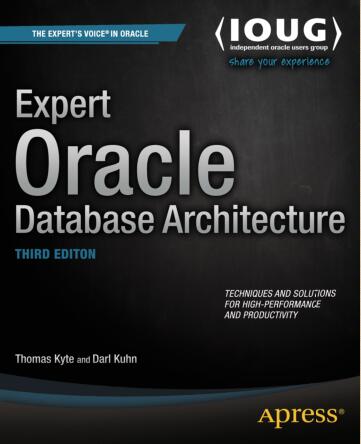Expert Oracle Database Architecture content validity
Now in its third edition, this best-selling book continues to bring you some of the best thinking on how to apply Oracle Database to produce scalable applications that perform well and deliver correct results. Tom Kyte and Darl Kuhn share a simple philosophy: “you can treat Oracle as a black box and just stick data into it, or you can understand how it works and exploit it as a powerful computing environment.” If you choose the latter, then you’ll find that there are few information management problems that you cannot solve quickly and elegantly.
This fully revised third edition covers the developments up to Oracle Database 12c. Significant new content is included surrounding Oracle’s new cloud feature set, and especially the use of pluggable databases. Each feature is taught in a proof-by-example manner, not only discussing what it is, but also how it works, how to implement software using it, and the common pitfalls associated with it.
Expert Oracle Database Architecture Catalog
About the Authors
About the Technical Reviewers
Acknowledgments
Introduction
Setting Up Your Environment
Chapter 1: Developing Successful Oracle Applications
Chapter 2: Architecture Overview
Chapter 3: Files
Chapter 4: Memory Structures
Chapter 5: Oracle Processes
Chapter 6: Locking and Latching
Chapter 7: Concurrency and Multiversioning
Chapter 8: Transactions
Chapter 9: Redo and Undo
Chapter 10: Database Tables
Chapter 11: Indexes
Chapter 12: Datatypes
Chapter 13: Partitioning
Chapter 14: Parallel Execution
Chapter 15: Data Loading and Unloading
Index
Expert Oracle Database Architecture Wonderful Digest
Consider, for example, Windows vs. UNIX/Linux. If you are a long-time Windows programmer and were asked to develop a new application on the UNIX/Linux platform, you’d have to relearn a couple of things. Memory management is done differently. Building a server process is considerably different—under Windows, you would develop a single process, a single executable with many threads. Under UNIX/Linux, you wouldn’t develop a single stand-alone executable; you’d have many processes working together. It is true that both Windows and UNIX/Linux are operating systems. They both provide many of the same services to developers—file management, memory management, process management, security, and so on. However, they are very different architecturally—much of what you learned in the Windows environment won’t apply to UNIX/Linux (and vice versa, to be fair). You have to unlearn to be successful. The same is true of your database environment.

→→→→→→→→→→→→→→→→→→→→查找获取




评论